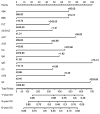A novel nomogram based on clinical blood indicators for prognosis prediction in curatively resected esophagogastric junction adenocarcinoma patients
- PMID: 37325058
- PMCID: PMC10266239
- DOI: 10.7150/jca.83588
A novel nomogram based on clinical blood indicators for prognosis prediction in curatively resected esophagogastric junction adenocarcinoma patients
Abstract
Background: The incidence of esophagogastric junction adenocarcinoma (EJA) patients was increasing but their prognoses were poor. Blood-based predictive biomarkers were associated with prognosis. This study was to build a nomogram based on preoperative clinical laboratory blood biomarkers for predicting prognosis in curatively resected EJA. Methods: Curatively resected EJA patients, recruited between 2003 and 2017 in the Cancer Hospital of Shantou University Medical College, were divided chronologically into the training (n=465) and validation groups (n=289). Fifty markers, involving sociodemographic characteristics and preoperative clinical laboratory blood indicators, were screened for nomogram construction. Independent predictive factors were selected using Cox regression analysis and then were combined to build a nomogram to predict overall survival (OS). Results: Composed of 12 factors, including age, body mass index, platelets, aspartate aminotransferase-to-alanine transaminase ratio, alkaline phosphatase, albumin, uric acid, IgA, IgG, complement C3, complement factor B and systemic immune-inflammation index, we constructed a novel nomogram for OS prediction. In the training group, when combined with TNM system, it acquired a C-index of 0.71, better than using TNM system only (C-index: 0.62, p < 0.001). When applied in the validation group, the combined C-index was 0.70, also better than using TNM system (C-index: 0.62, p < 0.001). Calibration curves exhibited that the nomogram-predicted probabilities of 5-year OS were both in consistency with the actual 5-year OS in both groups. Kaplan-Meier analysis exhibited that patients with higher nomogram scores contained poorer 5-year OS than those with lower scores (p < 0.0001). Conclusions: In conclusion, the novel nomogram built based on preoperative blood indicators might be the potential prognosis prediction model of curatively resected EJA.
Keywords: Clinical laboratory blood indicators; Esophagogastric junction adenocarcinoma; Nomogram; Prediction; Prognosis.
© The author(s).
Conflict of interest statement
Competing Interests: The authors have declared that no competing interest exists.
Figures





Similar articles
-
A Nomogram Based on Nutrition-Related Indicators and Computed Tomography Imaging Features for Predicting Preoperative Lymph Node Metastasis in Curatively Resected Esophagogastric Junction Adenocarcinoma.Ann Surg Oncol. 2023 Aug;30(8):5185-5194. doi: 10.1245/s10434-023-13378-7. Epub 2023 Apr 3. Ann Surg Oncol. 2023. PMID: 37010663 Clinical Trial.
-
Serum insulin-like growth factor binding protein 3 as a promising diagnostic and prognostic biomarker in esophagogastric junction adenocarcinoma.Discov Oncol. 2022 Nov 21;13(1):128. doi: 10.1007/s12672-022-00591-1. Discov Oncol. 2022. PMID: 36409444 Free PMC article.
-
Development and validation of a survival nomogram for patients with Siewert type II/III adenocarcinoma of the esophagogastric junction based on real-world data.BMC Cancer. 2021 May 10;21(1):532. doi: 10.1186/s12885-021-08249-x. BMC Cancer. 2021. PMID: 33971833 Free PMC article.
-
A Nomogram Based on Aspartate Aminotransferase/Alanine Aminotransferase (AST/ALT) Ratio to Predict Prognosis After Surgery in Gastric Cancer Patients.Cancer Control. 2020 Jan-Dec;27(1):1073274820954458. doi: 10.1177/1073274820954458. Cancer Control. 2020. PMID: 32959672 Free PMC article.
-
Development and validation of nomogram combining serum biomarker for predicting survival in patients with resected rectal cancer.Biosci Rep. 2019 Nov 29;39(11):BSR20192636. doi: 10.1042/BSR20192636. Biosci Rep. 2019. PMID: 31693739 Free PMC article.
Cited by
-
Machine learning-based prediction of gastroesophageal junction cancer using electronic medical records.Clin Exp Med. 2025 Aug 18;25(1):295. doi: 10.1007/s10238-025-01835-4. Clin Exp Med. 2025. PMID: 40820054 Free PMC article.
References
-
- Sung H, Ferlay J, Siegel RL, Laversanne M, Soerjomataram I, Jemal A. et al. Global Cancer Statistics 2020: GLOBOCAN Estimates of Incidence and Mortality Worldwide for 36 Cancers in 185 Countries. CA Cancer J Clin. 2021;71:209–49. - PubMed
-
- Siewert JR, Stein HJ. Classification of adenocarcinoma of the oesophagogastric junction. Br J Surg. 1998;85:1457–9. - PubMed
-
- Arnold M, Ferlay J, van Berge Henegouwen MI, Soerjomataram I. Global burden of oesophageal and gastric cancer by histology and subsite in 2018. Gut. 2020;69:1564–71. - PubMed
-
- Haga Y, Hato S, Ikenaga M, Yamamoto K, Tsuburaya A, Doi K. et al. Validation of an assessment tool: Estimation of Postoperative Overall Survival for Gastric Cancer. Eur J Surg Oncol. 2018;44:515–23. - PubMed
-
- Kudou K, Nakashima Y, Haruta Y, Nambara S, Tsuda Y, Kusumoto E. et al. Comparison of Inflammation-Based Prognostic Scores Associated with the Prognostic Impact of Adenocarcinoma of Esophagogastric Junction and Upper Gastric Cancer. Ann Surg Oncol. 2021;28:2059–67. - PubMed
LinkOut - more resources
Full Text Sources
Miscellaneous

